

Religious Dissection Comparative study of religions. Sub Rosa Magazine. Occult science. Occult science is the systematic research into or formulation of occult concepts in a manner that follows - in its method or presentation - the way natural science researches or describes phenomena of the physical world.

The idea of Occult Science appears in late-19th and early 20th century occultism, especially Theosophy, including: Religious symbolism. This article is about symbolism in religion.
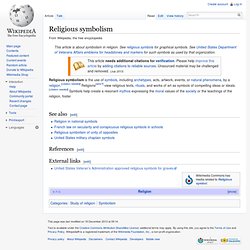
See religious symbols for graphical symbols. Tarot. Visconti-Sforza tarot deck.
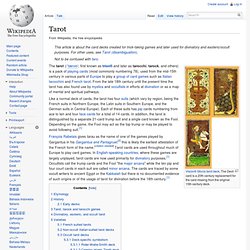
The Devil card is a 20th-century replacement for the card missing from the original 15th-century deck. François Rabelais gives tarau as the name of one of the games played by Gargantua in his Gargantua and Pantagruel;[2] this is likely the earliest attestation of the French form of the name. [citation needed] Tarot cards are used throughout much of Europe to play card games. In English-speaking countries, where these games are largely unplayed, tarot cards are now used primarily for divinatory purposes.[1] Occultists call the trump cards and the Fool "the major arcana" while the ten pip and four court cards in each suit are called minor arcana. Lilith. Lilith (Hebrew: לילית; lilit, or lilith) is a Hebrew name for a figure in Jewish mythology, developed earliest in the Babylonian Talmud, who is generally thought to be in part derived from a class of female demons Līlīṯu in Mesopotamian texts of Assyria and Babylonia.
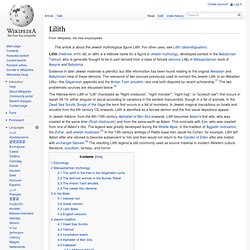
Evidence in later Jewish materials is plentiful, but little information has been found relating to the original Akkadian and Babylonian view of these demons. The relevance of two sources previously used to connect the Jewish Lilith to an Akkadian Lilitu—the Gilgamesh appendix and the Arslan Tash amulets—are now both disputed by recent scholarship.[1] The two problematic sources are discussed below.[2] The Hebrew term Lilith or "Lilit" (translated as "Night creatures", "night monster", "night hag", or "screech owl") first occurs in Isaiah 34:14, either singular or plural according to variations in the earliest manuscripts, though in a list of animals.
Etymology[edit] In Akkadian the terms lili and līlītu mean spirits. [edit] Shuo Kua. EXPLAINING THE CONFUSION - RIDERS THAT ARE KINGS, KINGS WHO ARE THE KNIGHTS, queens, princesses, pages, etc., etc., etc. "Discovering Tarot. O meu objetivo com esse post é um, e somente um: esclarecer, de uma vez por todas, a grande confusão que paira sobre as figuras da corte e seus ranks em diferentes decks de Tarot.
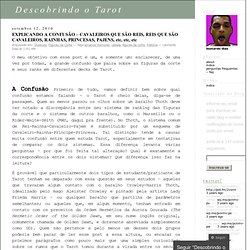
A Confusão Primeiro de tudo, vamos definir bem sobre qual confusão estamos falando – o Tarot é cheio delas, diga-se de passagem. Quem ao menos passou os olhos sobre um baralho Thoth deve ter notado a discrepância entre seu sistema de ranking das figuras da corte e o sistema de outros baralhos, como o Marseille ou o Rider-Waite-Smith (RWS, daqui pra frente). No Thoth, o sistema comum de Rei-Rainha-Cavaleiro-Pajem é substituído por um esquema de Cavaleiro-Rainha-Príncipe-Princesa. Tal distinção tende a causar muita confusão entre quem estuda Tarot, especialmente em tentativas de comparar os dois sistemas. Essa diferença levanta várias perguntas – por que foi feita tal alteração? Mas, chega de enrolação, é hora de descobrirmos alguns porquês. História Um pouco de história para começar. O Tetragrammaton . . 1. 2. Myan & Hopi Prophecy - Collecting Bromeliads and Orchids in Florida. White Feather, Bear Clan "The Fourth World shall end soon and the Fifth World will begin.
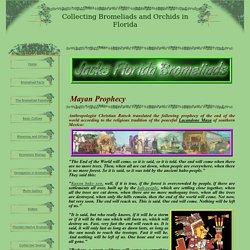
This the Elders everywhere know. The Signs over many years have been fulfilled and so few are left"
Hermeticism. Aleister Crowley. Time Cycles - Chance and Choice. Since Einstein we know without a doubt that reality is a space-time continuum where matter and energy are interchangeable.

Science and mathematics have learned a great deal about space, but very little about time. What we do know is strange. The passage of time is not objective, it relates to the velocity of matter. Thus as matter approaches the speed of light (the speed limit of matter), time slows to a near stop. A person traveling in a space ship moving at the speed of light thus would have no time and would not age.
Although new to science, the subject of time was carefully studied for millennia by many ancient cultures and traditions. Eliphas Levi. "Eliphas Levi", the name under which he published his books, was his attempt to translate or transliterate his given names "Alphonse Louis" into Hebrew although he was not Jewish.
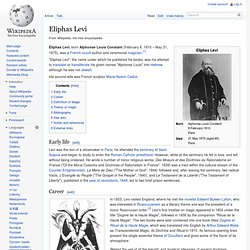
His second wife was French sculptor Marie-Noémi Cadiot. Early life[edit] Levi was the son of a shoemaker in Paris; he attended the seminary of Saint Sulpice and began to study to enter the Roman Catholic priesthood. However, while at the seminary he fell in love, and left without being ordained. He wrote a number of minor religious works: Des Moeurs et des Doctrines du Rationalisme en France ("Of the Moral Customs and Doctrines of Rationalism in France", 1839) was a tract within the cultural stream of the Counter-Enlightenment. Career[edit] Heinrich Cornelius Agrippa. Life[edit] Agrippa was born in Cologne on 15 September 1486. In 1512, he taught at the University of Dole in the Free County of Burgundy, lecturing on Johann Reuchlin's De verbo mirifico; as a result, Agrippa was denounced, behind his back, as a "Judaizing heretic".
Agrippa's vitriolic response many months later did not endear him to the University. In 1510, Agrippa studied briefly with Johannes Trithemius, and Agrippa sent him an early draft of his masterpiece, De occulta philosophia libri tres, a kind of summa of early modern occult thought. Trithemius was guardedly approving, but suggested that Agrippa keep the work more or less secret; Agrippa chose not to publish, perhaps for this reason, but continued to revise and rethink the book for twenty years.